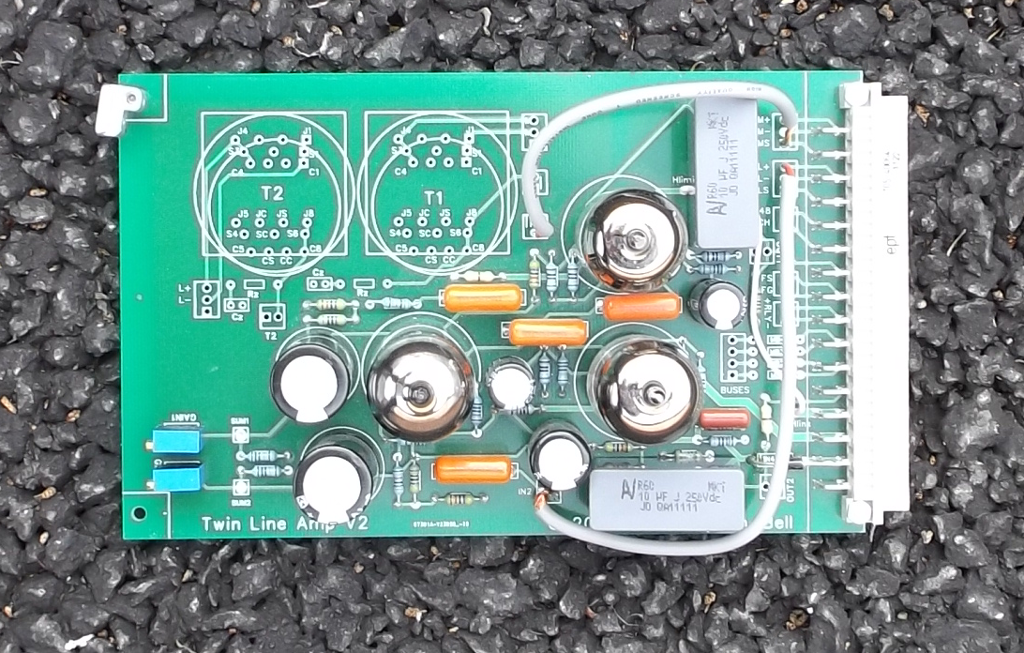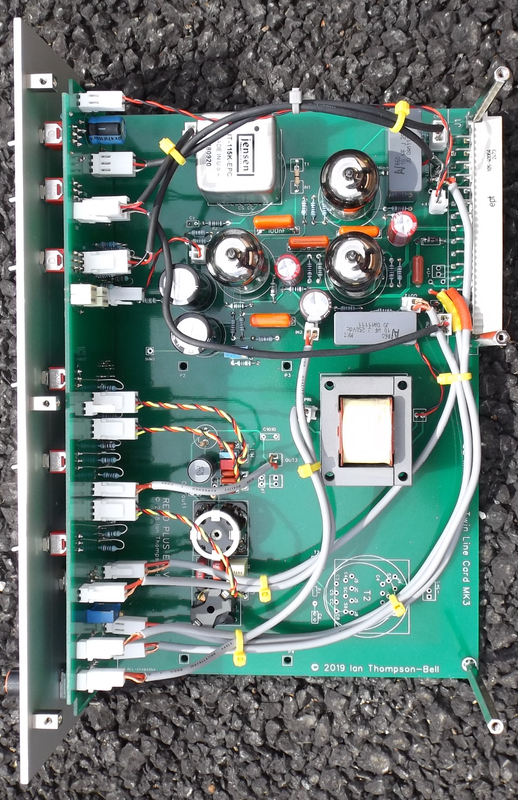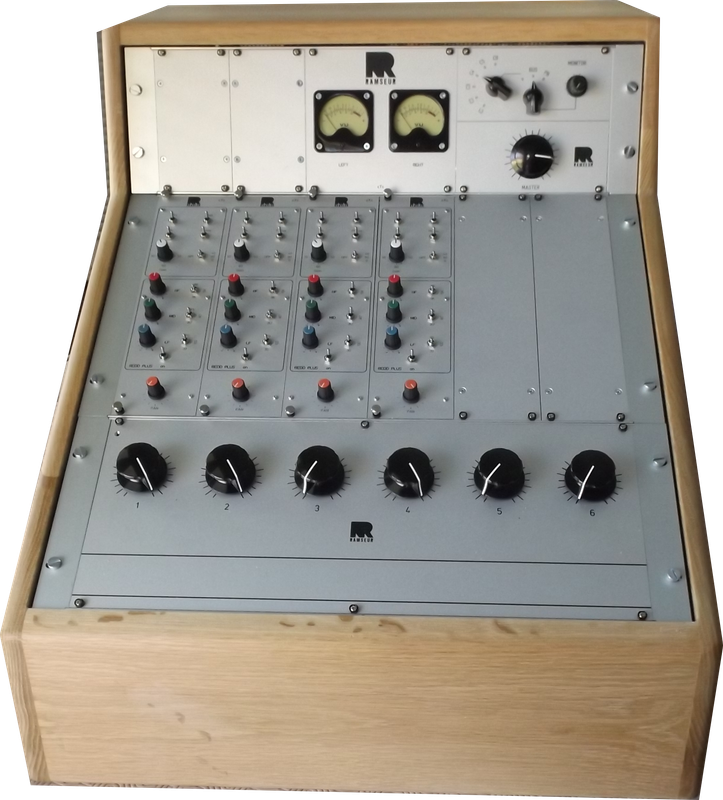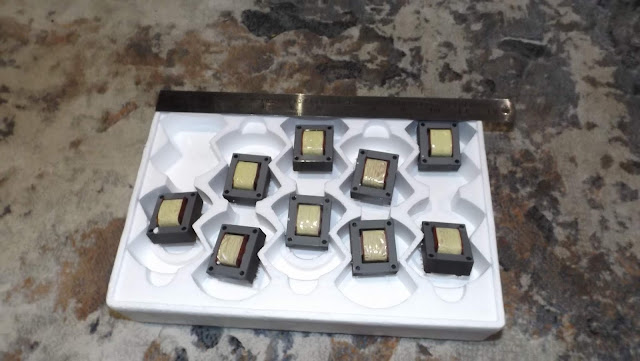During the Covid outbreak I had plenty of time to think about how the basic Mark 3 module design should be deployed in a real mixer. All the basic technical issues like mechanical rigidity, screening, attachment of front panel controls and finding the right low profile audio transformers have already been addressed but exactly what features and functions need to be included in a channel amp? The Channel One design fulfils all the basic needs of a stand alone mic/line pre and 3 band EQ but it includes nothing to help it function in a full mixer intended for both tracking, overdubbing and mix down. All that kind of thing is assumed to be external. The Channel One also had a lot of internal wring, much of it carrying low level signals so I wanted to look at how this could be reduced.
So, with the benefit of time on my hands I decided to step back to the old 8 Tracker design and began to think about how you would actually use it. For tracking the Channel One was fine. Mic and line inputs, stepped mic gain and a 3 band REDD EQ and a pre fader direct out. But 3 band EQ is a bit low end these days and there is a kind of natural 4th EQ band between the low and mid bands of the REDD EQ so I decided to look at squeezing in another EQ band.
So what about overdubs? You could feed the tape returns into the line inputs and manually switch each already recorded track from mic to line before you overdub but that is a bit cumbersome especially if you already have the line inputs wired up for synths for example. You don't really want to have to go round the back of the console and re-plug it every time you overdub. What you really need is a separate tape return input to the channel amp so you can just flip already recorded channels to tape play for overdubs. This could go through a big pad and into the mic pre just like the line ins but then you would end up tweaking the mic gain switch to set the tap return level. The tape return clearly needs its own trim control so it might as well bypass the the mic pre all together. So we need to find room for a tape return pot and switch.
Lastly, for mix down, we need to switch every channel input to its tape return. Again it would be tedious to have to flip every tape return switch on every channel to ON. So if the tape return switch operated a relay that switched in the tape return, we could have a big REMIX button in the monitor section that turned on this relay in every channel so they all flipped to playing tape returns in one go. However, even in REMIX, you might want to use spare channels for AUX returns so you need some way to override the auto REMIX action. And you still need to be able to flip individual channels to tape during overdub. In the end I came up with a three position switch that sets the "MODE" for each channel. The normal centre position is AUTO. Mic and line inputs work as normal but the monitor section REMIX button switches the channel to tape return. If you want to use the channel as a mic/line pre instead, you flip this switch to the REC (record) position which permanently overrides the tape return. For overdubbing, if you want to switch an individual channel to tape return the you flip this switch to PLAY which sets the channel permanently into tape return mode.
So we have added a relay for the tape return switching which leads naturally onto thinking about what other signals could sensibly be switched by relays so as to save on wiring. The mic and line inputs seem good candidates. Both have to be routed from the 32 way connector at the rear of the module, past three hot tubes to the front panel and then back to the mic input transformer. If they could both be routed to some relays and then into the mic input transformer the route would be much more direct and we would save three bulky screened leads. I came up with a design that uses four miniature DIL relays. One for the 48V phantom supply, one for the mic 20dB pad, one for the mic line selection and lastly one for phase inversion. Their dc control voltages connect to the front panel via a single 6 way ribbon cable. An added advantage of this method is that we can combine two functions into a single switch and thereby reduce the number of front panel switches. So, for example, a single three position toggle can switch from mic to mic with 20dB pad and then the line input. This all sounds good in theory but will it fit on the front panel and will it look OK or just be an awkward mess.
Regular readers will know I am mechanically dyslexic and I have zero artist skills as well. So I was very pleased when a fellow groupDIY member Jean http://cdlei.blogspot.com/ offered to design the front panel layouts and rationalise the placement of controls and switches on front panels across the entire mixer! We had already been discussing a CTC logo to go on the front panels and the discussion somehow morphed over a period of about 11 months into complete front panels designs Bottom line is here is the design that Jean came up with for the Mark 3 updated 8 tracker design.
The above image is of the very first front panel to this design received from Schaeffer. At the top are three toggles that control phantom, phase and mic/pad/line selection via relays. Beneath these is the rotary mic gain switch and the HPF. Next comes the 4 band REDD EQ section with four stepped boost/cut controls each with an associated three way toggle that selects the frequency. The last section contain the tape return section with its level control and three way mode switch. And of course right in the top right hand corner is the new CTC logo that started it all off.
A few days ago, the received the latest main board PCB incorporating the 4 band EQ , the new low profile output transformer and the tape return input. So here is the first picture of a completed Mark III 8 tracker channel amp.
The three tubes are at the top and to their right is the 32 way connector that plugs into the backplane PCB. About half way down the board are the four orange coloured relays for low level switching with the mic input transformer to their left. The black cable connects the mic input to the relays and is the only really low level cable now. Just to the right of the mic transformer is the ribbon cable connecting front panel switches to the relays. The bottom right hand corner has the Electro Mag output transformer and to its left are the four bands of inductor based EQ. A couple of 6 way ribbon cables connect the EQ to the front panel. The only part of the circuit not yet cables is the tape return which passes via the small transformer just above the Electro Mag.







